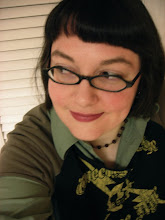Charting a Heel Turning
Zak keeps nagging me to blog about tech editing. I don't know if anyone is interested, but I really do derive a good deal of satisfaction from my job, and maybe it will turn out to be interesting after all. Let me know, all right?
I am not a sock knitter. I have knit exactly 3 pairs of socks, and only one of them used a conventional sock construction. I knit a mini-sock with a flap heel years ago, to better accquaint myself with sock theory, which is elegant and fascinating. However, when I started working as the technical editor for Knitty two and a half years ago, that was the only conventional sock heel I had ever turned.
I was rather daunted when I first had to edit a sock pattern. For a long time, I used to swatch the heel turning for every fucking sock pattern I edited, so I could be sure the directions were correct. And man, you guys like your socks, which is why Knitty publishes so many sock patterns.
By now I can work out almost anything knitting-related on paper, though I still have a working swatch in constant progress on my desk, which I use to test anything I'm not intimately familiar with. Though it is still punctuated by the occasional heel, I am pleased to say that I now have a better way to work out or check the numbers for the most common type of sock heel, the flap heel. Click for big, if you are so inclined.

Pretty, yes? This is the heel for one of the lovely socks in the upcoming Spring issue.
I do this in the OpenOffice spreadsheet program, which is also what I use to make the charts for Knitty.
I start by numbering the stitches at the bottom; this is the total number of stitches the heel flap has at the beginning.
The highlighted squares are the stitches that are knit or purled in each row, save the last stitch, which is just a K or P. I do it this way because it's the fastest and easiest for me, and because it gives me a chance to muck around with colour.
The k2tog and ssk symbols are surely familiar. Each time a stitch is decreased at the end of a row, I remove the borders from the column of stitches at the end of that row. This way I can see how many stitches are decreased within the course of a heel turning, and I can be sure the heel turning starts with the right numbers on those first two decisive rows.
I'm not sure why heel turning has remained more opaque to me than many other things in knitting, why I still need this kind of process and visual aid. I understand how they work and everything, but it remains something I can't break down easily on paper without going through the stitch-by-stitch process, on the computer or on my needles. I did have a epiphany moment when I was editing one pattern this issue, which started out with numbers that didn't quite work out evenly; I started to see how I could just reduce it to a formula, but it hasn't yet fully formed in my head.
Until it does, I have to admit I quite enjoy making these pretty striped charts. I also enjoy knitting all these socks in my head, though I have yet to convert to being an avid sock knitter with my needles.


8 Comments:
Oh my God, I understood the whole thing! ( I hate sock heels. I feel stupid because everyone say they're easy) But you Made it easy just now. You are a genious my friend. That's why you're my knitting idol!
Love /the Lisa
I'm thankful for your illustration and also that you are editing the knitty patterns. I kinda devised something charted while teaching the Carusoe sock from knitting at a class and found errors in the heel! Do ya'll ever post corrections? Anyway, thanks, Teri
Hi Mandy,
Just found your blog - I really like your writing.
I wish sock patterns could be charted, like your chart, rather than written. It makes much more sense to me, to "see" the knitting on paper
Mandy, I would love to read any and all posts about tech editing from you! Thanks for this one. I'm learning a lot from your tech edits, myself! This is so interesting - so great to get a look inside your process. Thanks!
As I already knew, you are a charting genius and I welcome this one! Great work...thank you!
And I DO want you to take a look at my new sock pattern if you have some time... ok?
Excellent explanation. I need to print this out so that the next pair of socks I knit won't be such a mystery!
Love your blog.
Esther
wow! your editing job sounds much more fun and interesting than mine. i primarily edit textbooks for hotel and restaurant students and for those already in the field. right now, tho', i'm recovering from wrist surgery i hlast thurs. [march 8], and can type with my left hand only. can't drive, shower, write, push, pull, or KNIT. i seriously need some cheering up today, and your description of your editing process was fun.
Hi, I'm incredibly late to this post but I'd really like it if you posted more about tech editing, also. I'm interested in tech editing, and would love to read a blog where someone knowledgeable talked about it.
Post a Comment
<< Home